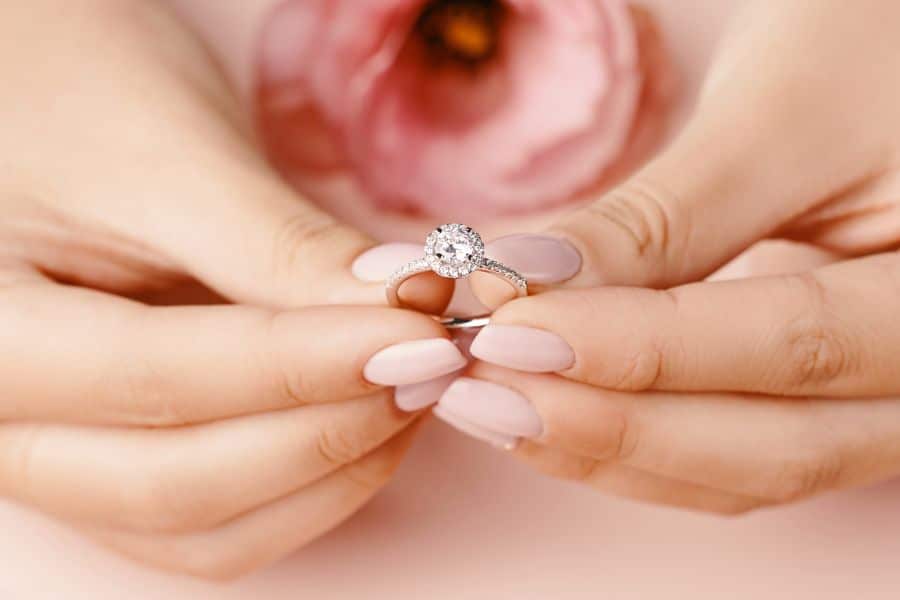
Most of us, regardless of if we are male or female, love rings and appreciate wearing them. However, buying a wedding ring can be quite challenging as your partner’s tastes may be unique, or we may not know what would suit them. They are fantastic for symbolizing eternal love, but you want to be sure that the ring you choose is just right.
We will start by giving you a brief introduction to the anatomy of the ring so you know precisely what we are referring to, then move on to the types of band, settings, and finally, the different kinds of metal you can use.
Table of Contents
Anatomy
All rings comprise similar component parts. Every ring will have a shank, commonly referred to as the band. However, some rings will have some other features, and just a few of these are detailed below:
- Setting
The setting which can sometimes be referred to as the head is where the main stone will be situated. There are many different setting styles; some are designed to allow maximum light to enter the stone, while others focus more on protection.
- Gallery
The gallery is located under the setting and is visible from the side. In some rings, the gallery can be barely visible; on others, it is a prominent feature and can sometimes house another stone.
- Shoulders or Accent
The shoulders, also known as the accent, are the sloping sides from the shank to the setting. On some rings, they will remain plain, but often they are adorned with a series of small gemstones.
- Prong
Prongs are a series of tiny metal claws rising from the setting, which will hold the stone in place. Typically, there will be four to six prongs, allowing a large amount of light to pass through the stone displaying a gem, such as a diamond’s famous sparkle.
- Bezel
A bezel is an alternative setting to the prongs and is almost like an egg cup in which the gemstone will sit. You can get full or half bezels, which are more secure than prongs but don’t allow the same amount of light to pass.
Types of Band
There are numerous different types of wedding bands that you can select. The shanks can vary significantly in terms of their width, depth and, of course, their design. The most common types of the band are a straight band and the traditional band, which are the same width all around. They may be what you associate with a man’s wedding ring. Tapered and reversed tapered rings are also prevalent where the band widens around the stone or shrinks.
Other frequently seen styles include the split shank and the reverse split shank, which, as the name would suggest, sees the shanks split in two. The less common but impressive types include the bypass, Euro shank, cathedral and curved. The curved can sometimes incorporate a twist or free-form designs.
Settings
The setting is an incredibly important feature of any wedding ring, and there are several factors that you will want to consider when choosing what is most vital for you or the person you are buying the ring for. Here are some of the most common settings:
- Prong Setting
The prong setting is one of the most easily recognizable settings and uses claws to hold the stone in place. Prongs can be rounded, pointed, flat or V-shaped – almost all of these types of setting use 4-6 prongs.
- Bezel Settings
As we touched upon above, the bezel settings can be full or half bezel. Men often prefer a robust setting as the stone is securely held in place.
- Channel Setting
The channel setting involves stones being held in place by two parallel metal strips that go around the ring’s outer edge, giving the impression of a channel. It is a secure setting that allows little light to enter the stone.
- Pave Settings
The pave setting is where a series of gems at set in small holes with a piece of metal between each, rather like a set of stepping stones. This type of setting is sometimes referred to as a bead setting.
- Other Settings
There are many other different types of settings, but some of the best known are the bar setting, tension setting, burnish setting, an illusion setting. All have their characteristics and can accentuate the features of different gems.
Types of Metal
Many different types of metals are used for wedding rings, including yellow, white and rose gold, silver, platinum and titanium. In addition, other metals have qualities, and various finishes can also be applied to change their appearance to differing degrees.
Gold
Today’s jewelry is forged with gold, which has been the standard for engagement and wedding rings. Mixed with other precious metals results in various shades, including yellow, white, and green, but rose gold is increasingly popular these days. So, choose the one that matches your skin tone. Fortunately, gold is never boring, thanks to its variety in colour.
Platinum
When it comes to durability, a platinum wedding ring is truly a winner. Unfortunately, it is also a rare metal that can only be found in a few locations worldwide. This makes platinum way harder to find and even more expensive than gold. However, it is a strong metal and a popular choice when crafting a piece of jewelry that will be worn for a long time. So, platinum is the right way to go if you are looking for metal for your heirloom quality jewelry.
Sterling Silver
The whitest of all the metals out there, Sterling Silver offers the best contrast with colourful gemstones and other coloured metals. This precious metal has been valued for centuries and is currently one of the most affordable metals you can buy. Since silver is too soft for jewelry, it is combined with other metals like copper to improve its strengths.
While these are the top three precious metals we can name, you can also consider some alternatives, such as stainless steel, tungsten, and cobalt. Although they may not be the most popular metals in engagement rings, they also offer stunning looks for a wedding band.
We recommend visiting the education guide from ICONIC for more insights about fine jewelry and precious metals.
Infographic – How much money should you spend on a wedding ring
If you are looking for wedding dresses, bridesmaids or mother-of-the-bride gowns, check out BestForBride.com.









![Celebrity-Inspired Wedding Dresses from the Red Carpet to the Aisle [2024]](https://i0.wp.com/www.bestforbride.com/bridal-shop/wp-content/uploads/2023/12/Experience-the-Magic-Celebrity-Inspired-Wedding-Dresses-from-the-Red-Carpet-to-the-Aisle.jpg?ssl=1)
![Stay Prepared for Unexpected Last-Minute Wedding Dress Emergencies: 8 Key Scenarios [2024]](https://i0.wp.com/www.bestforbride.com/bridal-shop/wp-content/uploads/2023/12/Stay-Prepared-for-Unexpected-Last-Minute-Wedding-Dress-Emergencies-8-Key-Scenarios.jpg?ssl=1)





After receiving a huge diamond ring for a wedding band, I learned that my tomboy lifestyle was not really a fit for that style. Thank you for suggesting the durability of platinum. That goes for both bride and groom.
Great tips I love to wear jewelry that enhances the appearance and I like this article so much. Thanks a lot for sharing.
I loved when you talked about there are lots of different types of metals used for wedding rings, including yellow, white, and rose gold, silver, platinum, and titanium. In the case of my wife, she didn’t lose it, but she damaged it. I will be looking for the finest jewelry repair services in town to have it restored.
Only this post proved that any body is not equal you and your level
It made sense when you mentioned that gold is the norm for engagement rings. My friend is looking for a vintage-style oval halo engagement ring for his girlfriend. I think that’s possible if he can find a jewelry store that provides a wide selection of engagement rings.